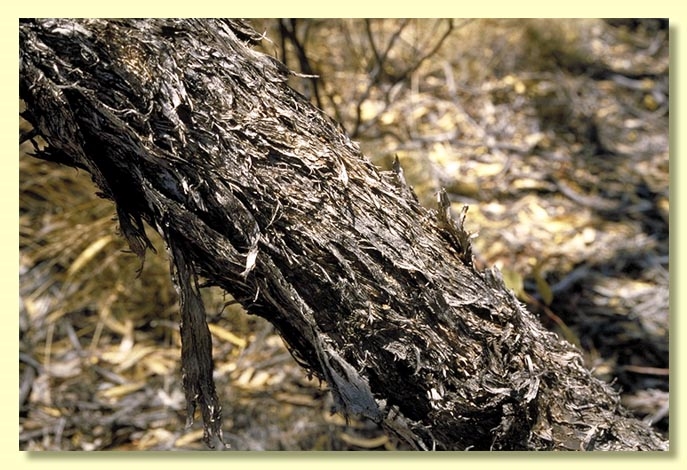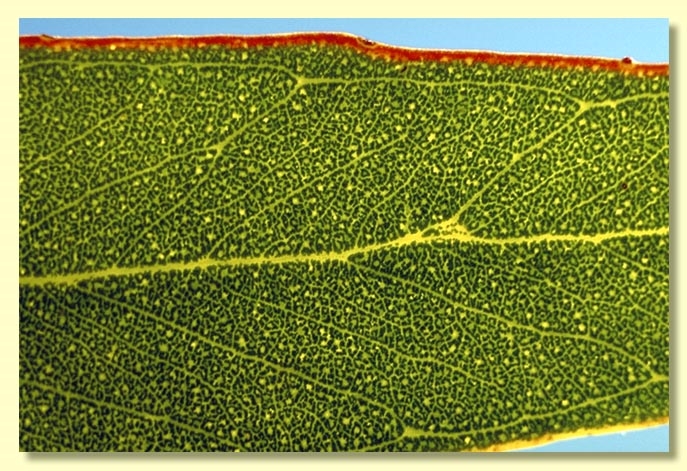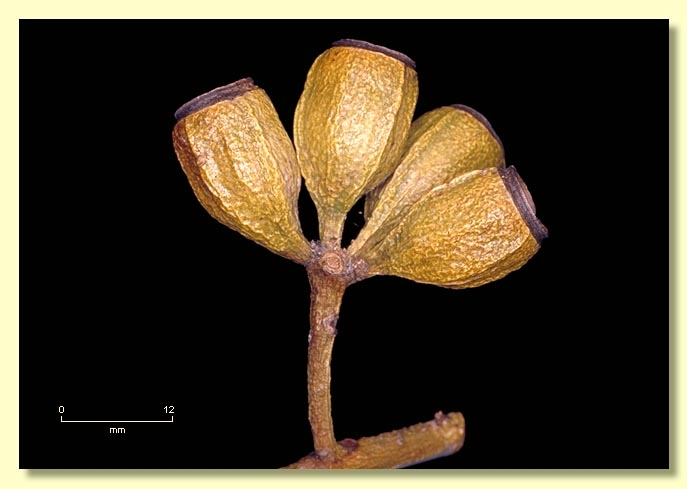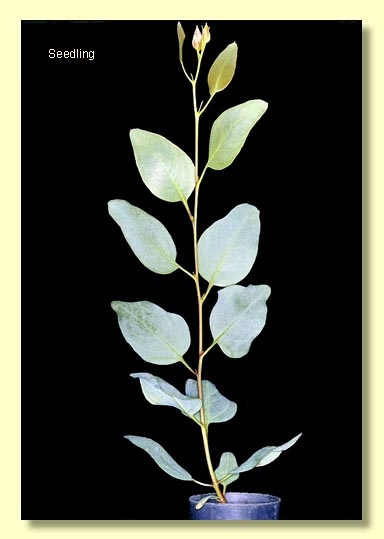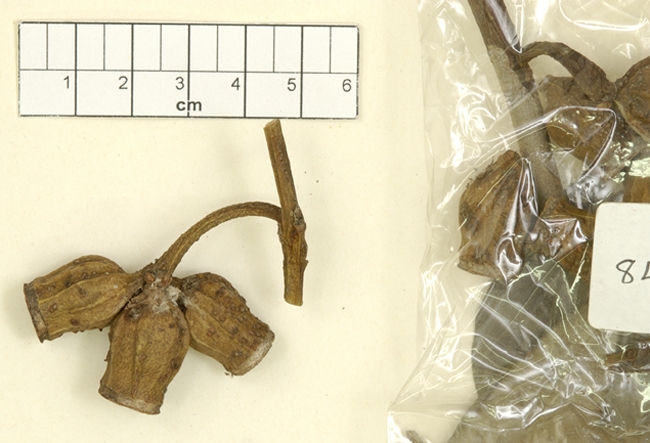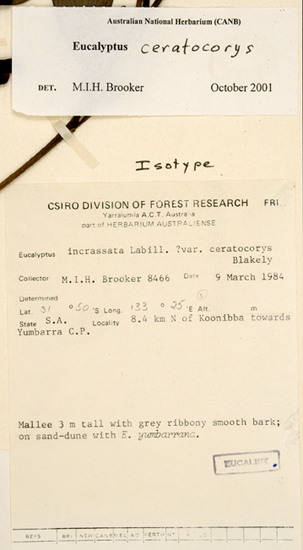Euclid - Online edition
Eucalyptus ceratocorys
Eucalyptus | Symphyomyrtus | Dumaria | Incrassatae
Eucalyptus angulosa var. ceratocorys Blakely, Key Eucalypts 124 (1934). T: Comet Vale, W.A., Dec. 1916, T.Jutson 116A; lecto: NSW.
Eucalyptus capitanea L.A.S.Johnson & K.D.Hill, Telopea 9: 270 (2001). T: South Australia: 8.4 km N of Koonibba towards Yumbarra Conservation Park, 9 Mar. 1984, M.I.H.Brooker 8466; holo: NSW; iso: CANB, PERTH, MEL, AD.
Bark rough for up to 3 m of the trunks of larger plants, with grey-brown shaggy, ribbony bark not shedding cleanly, smooth above, or on smaller plants smooth throughout, creamy grey to grey-brown.
Branchlets usually without oil glands in the pith, rarely 1 or 2 clear pith glands present at nodes.
Juvenile stems square in cross-section; juvenile leaves always petiolate, opposite for a few pairs then alternate, ovate, 6.5–8.5 cm long, 4–4.5 cm wide, base tapering to petiole, greyish green.
Adult leaves alternate, petiole 1–3 cm long; blade lanceolate, 6–15.5 cm long, 1.2–4.5 cm wide, base tapering to petioles, margins entire or shallowly and distantly denticulate due to lenticels, concolorous, thick, glossy, green, side-veins at an acute or wider angle to midrib, densely reticulate, intramarginal vein distant from margin, oil glands intersectional.
Inflorescence axillary unbranched, erect or pendulous, peduncles broadened apically, 1.3–3 cm long, buds (3)7 or 9 per umbel, pedicels 0.3–0.6 cm long. Mature buds obovoid to pyriform, ridged longitudinally (1.7–3 cm long, 0.6–1.1 cm wide), scar present, operculum beaked (1–1.5 cm long), stamens inflexed, anthers oblong to broadly wedge-shaped, versatile, dehiscing by lateral slits (non-confluent), style long, stigma blunt to tapered, locules 3(4), the placentae each with 4 vertical ovule rows. Flowers white to creamy, rarely red.
Fruit pedicellate (pedicels 0.1–0.7 cm long), cylindrical, slightly narrowed apically or sometimes 'waisted', ridged longitudinally, 1.2–2 cm long, 0.8–1.6 cm wide, disc descending, valves 3(4), enclosed.
Seeds grey-brown to grey, 2–5.5 mm long, flattened-pyramidal to cuboid, margin with a narrow encircling wing, sides ridged, dorsal surface shallowly reticulate, hilum more or less terminal.
Cultivated seedlings (measured at ca node 10): cotyledons reniform; stems square in cross-section; leaves always petiolate, opposite for 4 or 5 nodes then alternate, ovate-lanceolate, 7.5–9.5 cm long, 3–5 cm wide, dull, grey-green at lower nodes but glossy, green by node ca 8.
Flowering has been recorded in September and November.
A mallee of widespread but disjunct, poorly documented distribution, occurring on red sand, from near Koorda in the northern wheatbelt of Western Australia east to the southern fringe of the Great Victoria Desert in both Western Australia and South Australia extending sporadically to the Eyre Peninsula. The bark is loose and ribbony on the lower part of the stems and the adult leaves are thick, glossy green.
Eucalyptus ceratocorys belongs in Eucalyptus subgenus Symphyomyrtus section Dumaria because the buds have two opercula, stamens are strongly inflexed, ovules are in 4 rows on the placentae and cotyledons are reniform. E. incrassata, E. angulosa, E. captiosa, E. singularis and E. ceratocorys are closely related within this section Dumaria, together forming series Incrassatae.
E. ceratocorys has buds and fruit that are contracted below the join of operculum and hypanthium, and have prominently beaked opercula. The branchlets usually lack pith glands. E. angulosa is a mallee of coastal headlands and dunes with very coarse leaves, buds and fruits. E. incrassata has slightly smaller buds, fruits and leaves compared with both E. angulosa and E. ceratocorys, and is sub-coastal to inland in distribution as a component of mallee communities. The narrow-leaved and small, cylindrical-budded E. captiosa is a sub-coastal mallee in distribution. The recently described mallet, E. singularis, is restricted to a small area north-west of Ravensthorpe and has clusters of prominently beaked buds on slender pendulous peduncles.
The recently described species E. capitanea from the Yumbarra area of South Australia is here regarded as synonymous with E. ceratocorys.


